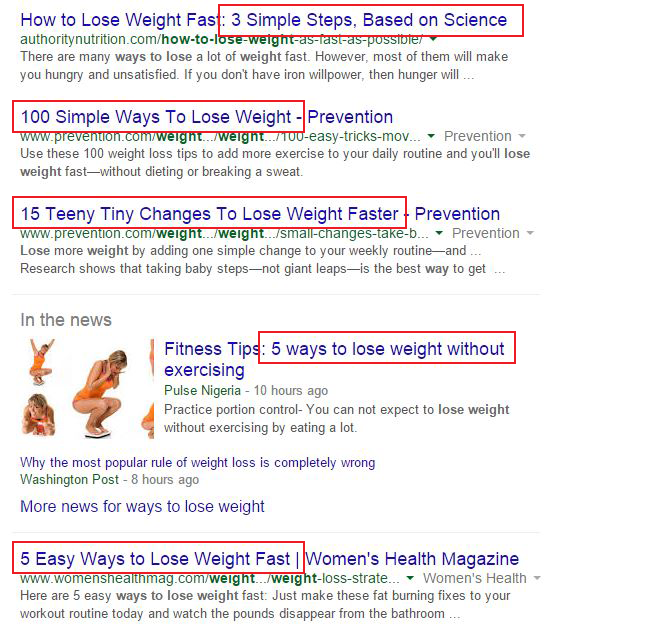Steph W. from SEOPressor


...help you check your website and tell you exactly how to rank higher?


97
score %
SEO Score

Found us from search engine?
We rank high, you can too.
SEOPressor helps you to optimize your on-page SEO for higher & improved search ranking.
By vivian on September 9, 2019

Writing blog post titles is easy, but writing blog titles that could bring in massive traffic is a whole other story.
To write great blog titles, you’ll need to first understand what kind of titles attract the most traffic and has the highest click-through rate.
Once you’ve understood these factors, you’ll be able to craft blog titles that bring real traffic to your blog.
Below are 12 ways you could use to easily create blog titles that will bring massive traffic to your blog.
Trending topics get a high volume of searches because they’re what people are currently most interested in. Consider visiting a social media site like Reddit or Twitter and see what people are talking about. Better still, you can also use a tool like BiQ’s Keyword Intelligence to find trending searches for creative blog post title.

Simply enter your targeted keyword or phrases in the module’s search bar. You will see a list of trending topics together with their metrics; trend, volume, CPC, competition, and the types of intent.

These metrics will give you a better insight into the popularity of the topic. For example, a high keyword volume means people are actively searching for this keyword. You can then use this information to guide you in deciding which topic to write.
** Get a free tier account and check your trending topics using Keyword Intelligence right away!
From there, give your company or industry’s perspective on the matter, with an eye towards providing new and useful data. There’s always something new trending in society, so this is a resource that never runs out.
If you’re not reading other blogs, you’re missing out on your chance to see what others are using for blog titles. Take the time to search the internet for at least one blog in each of the following areas:
This will get you a good cross-section of content and help you understand how people in different areas approach the creation of blog titles. Another way to approach this is through following specific writers and authors like Ernest Hemmingway or David Ogilvy and emulate their eye-catching writing habits.
There are extremely useful tools out there such as RankingGap that can ease your content hunt a lot. If you want to get inspiration from others…especially your competitors’ content and title, RankingGap does it for you.

Like how it’s shown in the image up there, you get to see the titles of your competitors’ works, their ranking for that particular content, and how you fare against them.
It amazingly saves you lots of time.
If you search a term on Google, high chances are, you’ll see more than half of the websites have titles that contain numbers. For example, I searched the term “lose weight” and unsurprisingly, found quite a number of titles with numbers in them.

In a study conducted by Moz and Conductor, they analyzed a large set of titles across publication sites and social networks to find out which type of headlines are most preferred.
They determined that there are five types of high-level headlines:

And as you would have guessed, number-type headlines are the most preferred headlines, a full 15% more than second-placed “reader addressing”.
The reason why people love headlines with numbers is simple, it’s easy to read and understand. It allows them to quickly skim over important information and focus more on the content that matters to them.
Here’s another blogging tip: You still need to provide valuable content, no matter how few or how many items your list has. Try to devote about a hundred words to each item on the list. For reference, that’s exactly what we’ve done here – this length is long enough to provide details but short enough to be quickly devoured.

The best blog titles are short – around nine words and sixty characters at most. Readers may not even read the full title of your page if they think it’s too long, especially when they’re casually browsing around. There’s really nothing else to say about length – it is what it is, and you’ll keep it in mind if you’re serious about writing blogs.
Click here to learn how to write conversationally to increase readership.
The best blog titles should never be ambiguous. In one glance, a potential reader should be able to understand exactly what type of content the post contains. Consider the following titles:
It’s not hard to tell which of these is a better title. More importantly, clarity helps you sift out readers who are simply going to bounce away from your blog a few seconds after arrival.
Clear, straightforward titles actively contribute to a higher conversion rate, allowing you to spend more of your previous advertising efforts on people who are actually likely to buy.
At the same time, it’s important to avoid creating clickbait titles as though they may attract a high number of clicks, which can have very detrimental effects on your website.
What if you could just toss out a keyword and get a list of outstanding blog titles?
That’s the purpose of our Blog Title Generator. Pair it with Keyword Intelligence, a free tool that analyzes relevant keywords to come up with a list of optimized titles.
The SEO tool also helps you approach the subject from a new angle, and these types of programs are reliable enough to become a permanent part of your content creation strategy.
Enter your keyword and click the ‘Content Ideas’ in the Keyword Intelligence. You will find a list of topics that you can immediately start to write.
For example, when I type in ‘social media marketing’, the tool comes up with this list of ideas:

Another feature that I love about this free tool is it gives me more than just ‘ideas’. You can actually see their volume and trend, side-by-side. This lets you know if people are looking or really interested in that particular topic. Give BiQ Cloud a try for free now!
If possible, try to explain the benefits to the reader, or at least write a title that speaks to something they care about. Inbound marketing techniques focus on providing value to the reader because that’s what the average person is looking for.
By stating the benefits, you are giving your readers a reason to click into your article.
For example:
The sooner you can deliver some kind of value, the more likely that person is to become interested in what you have to say.
[bof_display_offer id=8218]

Sensationalized blog titles have a measurably higher click-through rate.
In this very post, for example, we’re not just telling you how to create blog titles… we’re telling you how to create blog titles that bring MASSIVE traffic.
Even better, they’re easy once you get the hang of them. Like it or not, people tend to click on sensationalized titles as compared to boring titles. All of this is part of a basic structure, designed to appeal to the average reader, and it goes like this:
Content that is exciting, easy to read, and offers valuable information is worth the time it takes to read. That sense of excitement is what drives people to actually click, so you want to incorporate it whenever you can.
There’s a reason that BiQ Keyword Intelligence asks for the keyword of your blog. Keywords are the subject of the content, telling readers what the material is actually about.
In our case, the keyword is ‘Blog Titles’, and every other word of the title is a modifier explaining more about how we’re approaching the subject. If you don’t explain the subject, your click-through rate will fall flat – this is more important than any other part of your title.
Occasionally, you’ll have the opportunity to add some kind of catchy key phrase to your title. It may be a marketing slogan, a rhyme, or something a famous person said – either way, you’ll want to use it because catchy titles are far more exciting than basic, dull descriptions.
Besides catchy keyphrase, you can also use catchy and emotion-evoking words such as “free”, “because”, and “discover”. Find out more emotion-evoking words: 28 Emotional Words For Creating The Best Headlines (and why)
(Above) Banksy’s graffiti art has gained worldwide attention due to its controversial nature.
The controversy is interesting and therefore tends to get clicks. Don’t bother to take a safe, neutral middle ground when you can take a specific position instead, explaining why your views make more sense. You should not devolve into libel or personal attacks. You don’t want to look like a jerk nobody wants to be around – especially if you can deliver an eloquent, persuasive post instead.
By this point, you’re probably wondering how you’re actually going to fit all of these pieces of advice into nine words. Honestly… you aren’t. There’s no way to do every single one of these all the time, every time. Our language simply doesn’t work that way.
However, you can get close by following this straightforward formula – write it on a sticky note and place it close to your computer for easy reference. The formula is:
[Number or Trigger Word] + [Adjective] + [Keyword] + [Promise]
For example, “18 Incredible Ways You Can Feed a Lion Indoors”.
Let’s go through our checklist, shall we? This title…
When in doubt, look at this simple formula again and follow it as closely as you can to generate catchy blog post titles to attract massive traffic. Or if you are looking for a more automated process, check out this guide on SEO title generator.
[This blog post was first written and published by Zhi Yuan on April 27, 2015. It is most recently updated by Vivian on Jun 28, 2020]
Related Links:
Updated: 7 December 2025


Save thousands of dollars (it’s 100x cheaper)

Zero risk of Google penalty (it’s Google-approved)

Boost your rankings (proven by case studies)
Rank High With This Link Strategy
Precise, Simplified, Fast Internal Linking.
